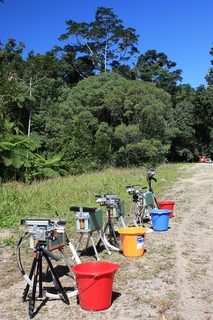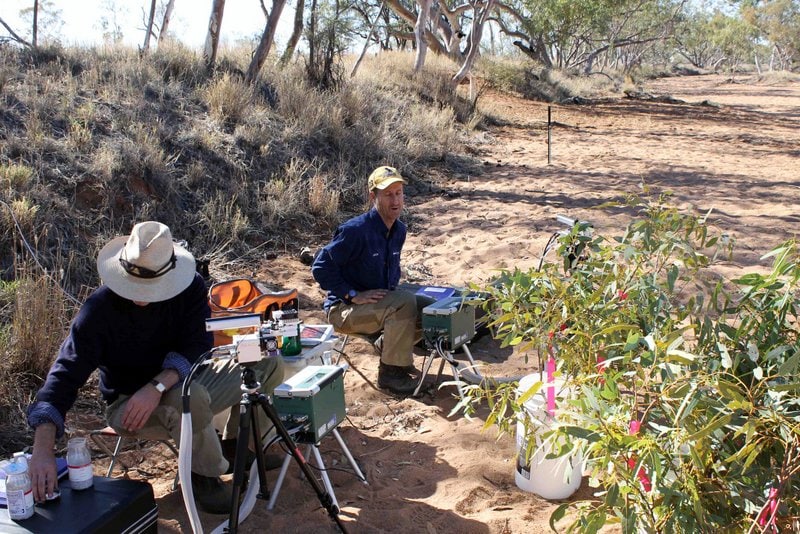Data publication from TERN repositories continues to grow and so too do the number of researchers utilising TERN’s resources and services.
This month we feature ecophysiology and plant trait data collected by researchers using TERN’s open-access data collection methods of ecosystem process monitoring SuperSites and subsequently reused in new scientific research.
- Functional trait and physiology data from seven TERN SuperSites
- Leaf trait data from South Australia's Mt Lofty Ranges
“TERN has open-access sites in almost all the major biomes of the globe.”
Our first four featured datasets come from a team of researchers who took advantage of TERN’s open-access nation-wide research sites to conduct their fieldwork. Professor Owen Atkin, of the Australian National University and the ARC Centre of Excellence for Plant Energy Biology, was one of the researchers.
“Back in 2009 we wanted to compare the metabolisms of warm and cold wet forests and we came across the research sites that TERN has just established,” said Owen. “What started with field campaigns using TERN sites in Queensland and Tasmania, soon turned into research at seven TERN sites in multiple biomes all around Australia.”

“I can’t overstate the value of TERN’s sites for researchers wanting to study a diverse range of ecosystems,” said Owen. “TERN has open-access sites in almost all the major biomes of the globe.”
“When you compare this to the situation overseas, for example in Europe, being able to study multiple ecosystem types under the same governance system, and language, is so advantageous for Australian researchers.”
“Plus, working at TERN sites means you have logistical help and a team of on-ground experts to collaborate with. TERN’s Australia-wide infrastructure is extraordinarily useful.”
Since collection and publication via TERN, Owen and his colleagues’ leaf trait and physiology data have been used in a host of new analyses. The data have facilitated a number of recent peer-reviewed papers including a continental‐scale assessment of variability in leaf traits; an analysis of global variability in leaf respiration; and a comparison of leaf respiration between the tropical forests of French Guiana, Peru and Australia.
Moreover, the samples collected by Owen and others at the TERN sites have even been used to better understand why plant water-use efficiency varies around Australia.
Data collection name & description | Licensing* | ||
|---|---|---|---|
Plant Functional Traits, Various Sites, 2010-2014 Key leaf traits describing their structure, chemistry and metabolism. Data include measurements repeated at contrasting seasons between 2010 and 2014 across seven TERN SuperSites (Alice Mulga, Calperum Mallee, Cumberland Plain, Cape Tribulation, Robson Creek, Great Western Woodland, and Warra). Temporal coverage: 2010 – 2014 |  | ||
Data on: (1) rates of leaf respiration (both in darkness and in the light) and associated leaf traits in a wide range of tropical tree species; (2) the extent to which rates of leaf respiration and associated traits change in response to changes in light availability within the canopy; and (3) the temperature dependence of leaf respiration of tropical tree species, using leaves sampled from the top and lower positions of the canopy. Temporal coverage: 2012 |  | ||
Set-up of AI curves, N, P and LMA values for dominant species. Data on the extent to which rates of respiration in the light change in response to associated traits and to climatic moisture in Robson Creek. Temporal coverage: 2012 |  | ||
Leaf Level Physiology, Chemistry and Structural Traits, Great Western Woodlands SuperSite, 2014 Set-up of ACi curves, N, P and LMA values for dominant species. Data on the extent to which rates of light-saturated photosynthesis, Vcmax and Jmax change in response to associated traits and to climatic moisture in the Great Western Woodlands. Temporal coverage: 2014 |  | ||


Dawn parade at TERN’s Robson Creek Rainforest SuperSite in QLD (above) and Great Western Woodlands SuperSite in WA (below), LiCor gas analysers at the ready (images courtesy Owen Atkin)

Adaption of plants to arid conditions
Our final two plant trait datasets this month also come from researchers using TERN’s open-access research sites. Zdravko Baruch and his colleagues from the University of Adelaide collected the data on Narrow-leaf Hopbush (Dodonaea viscosa subsp. angustissima) from TERN’s Ecosystem Surveillance monitoring plots in South Australia.
Since publication with TERN these data have been used in multiple analyses that investigate the adaptation of plants to arid conditions and their ability to cope with climate change.







